We have given these Accountancy Class 12 Important Questions and Answers Reconstitution of a Partnership Firm: Change in Profit Sharing Ratio Among the Existing Partners to solve different types of questions in the exam. Go through these Class 12 Accountancy Reconstitution of a partnership firm: Change in Profit Sharing Ratio Among the Existing Partners Class 12 Important Questions and Answers Solutions & Previous Year Questions to score good marks in the board examination.
Reconstitution of a Partnership Firm: Change in Profit Sharing Ratio Among the Existing Partners Important Questions Class 12 Accountancy
Question 1.
Anant, Gulab and Khushbu were partners in a firm sharing profits in the ratio of 5 : 3 : 2. From 1st April, 2014, they decided to share the profits equally. For this purpose, the goodwill of the firm was valued at ₹ 2,40,000.
Pass necessary journal entry for the treatment of goodwill on change in the profit sharing ratio of Anant, Gulab and Khushbu. (All India 2015)
Answer:

Working Note:
(i) Calculation of Change in Profit Share of Partners
Sacrificing/(Gaining) Share = Old Share – New Share
Anant’s Sacrifice/(Gain) = \(\frac { 5 }{ 10 }\) – \(\frac { 1 }{ 3 }\) = \(\frac { 15-10 }{ 30 }\) = \(\frac { 5 }{ 30 }\) Sacrifice
Gulab’s Sacrifice/(Gain) = \(\frac { 3 }{ 10 }\) – \(\frac { 1 }{ 3 }\) = \(\frac { 9-10 }{ 30 }\) = (\(\frac { 1 }{ 30 }\)) Gain
Khushbu’s Sacrifice/(Gain) = \(\frac { 2 }{ 10 }\) – \(\frac { 1 }{ 3 }\) = \(\frac { 6-10 }{ 30 }\) = (\(\frac { 4 }{ 30 }\)) Gain
(ii) Calculation of Share of Goodwill
Anant = 2,40,000 × \(\frac { 5 }{ 30 }\) = ₹ 40,000 30
Gulab = 2,40,000 × \(\frac { 1 }{ 30 }\) = ₹ 8,000 30
Khushbu = 2,40,000 × \(\frac { 4 }{ 30 }\) = ₹ 32,000
![]()
Question 2.
Give the meaning of ‘reconstitution of a partnership firm’. (All India: Delhi 2014)
Answer:
Change in the existing agreement of partnership is considered as reconstitution of a partnership firm.
Due to this, existing agreement comes to an end and the new agreement comes into existence and the firm continues.
Question 3.
State the ratio in which the partners share the accumulated profits when there is a change in the profit sharing ratio amongst the existing partners. (All India 2013)
Answer:
Accumulated profits are distributed in old profit sharing ratio, at the time of change in profit sharing ratio amongst the existing partners.
Question 4.
State the ratio in which the partners share profits or losses on revaluation of assets and liabilities, when there is a change in profit sharing ratio amongst the existing partners. (Delhi 2013)
Answer:
Revaluation profits or losses are distributed in old profit sharing ratio, at the time of change in profit sharing ratio amongst the existing partners.
Question 5.
State any two occasions on which a firm can be reconstituted. (Delhi 2012)
Or
List any two situations which may result in the reconstitution of a partnership firm. (All India 2011)
Answer:
A firm can be reconstituted on the following occasions (any two)
- When there is a change in the profit sharing ratio of existing partners.
- When a new partner is admitted.
- When an existing partner retires.
- When an existing partner dies.
Question 6.
Why are ‘reserves and surplus’ distributed at the time of reconstitution of the firm? (Delhi; All India 2010)
Answer:
At the time of reconstitution of the firm, reserves and surplus should be transferred to old partners capital/current accounts in their old profit sharing ratio because the new partner is not entitled to any share in such undistributed profits or losses as these are eamed/accrued by the old partners.
Question 7.
Hari, Kunal and Uma are partners in a firm sharing profits and losses in the ratio of 5 : 3 : 2. From 1st April, 2018 they decided to share future profits and losses in the ratio of 2 : 5 : 3. Their Balance Sheet showed a balance of? 75,000 in the Profit and Loss Account and a balance of? 15,000 in Investment Fluctuation Fund. For this purpose, it was agreed that:
(i) Goodwill of the firm was valued at ₹ 3,00,000.
(ii) Investments (having a book value of ₹ 50,000 were valued at ₹ 35,000.
(in) Stock having a book value of ₹ 50,000 be depreciated by 10%.
Pass the necessary journal entries for the above in the books of the firm. (All India 2019)
Answer:
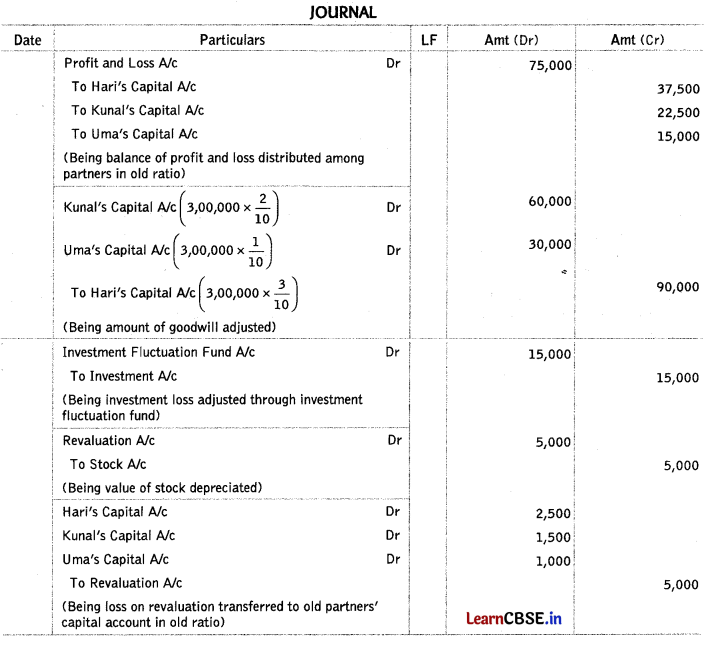
Working Note:
Calculation of Gaining or Sacrificing Ratio
Sacrificing Ratio = Old Ratio – New Ratio
Hari = \(\frac{5}{10}-\frac{2}{10}=\frac{3}{10}\); kunal = \(\frac{3}{10}-\frac{5}{10}=\left(\frac{2}{10}\right)\); Uma = \(\frac{2}{10}-\frac{3}{10}=\left(\frac{1}{10}\right)\)
Question 8.
Satish and Taruna were partners in a firm sharing profits and losses in the ratio of 3 : 2. From 1st April, 2018 they decided to share profits equally. On that date, their Balance Sheet showed a credit balance of ₹ 35,000 in workmen compensation fund and ₹ 40,000 in general reserve. The goodwill of the firm on that date was valued at ₹ 50,000. The firm accepted a claim of ₹ 40,000 for workmen compensation.
Pass necessary journal entries for the above transactions on the reconstitution of the firm. (All India 2019)
Answer:
Calculation of Sacrificing or Gaining Ratio
Sacrificing Ratio = Old Share – New Share
Satish = \(\frac{3}{5}-\frac{1}{2}=\frac{6-5}{10}=\frac{1}{10}\)
Taruna = \(\frac{2}{5}-\frac{1}{2}=\frac{4-5}{10}=\left(\frac{1}{10}\right)\)
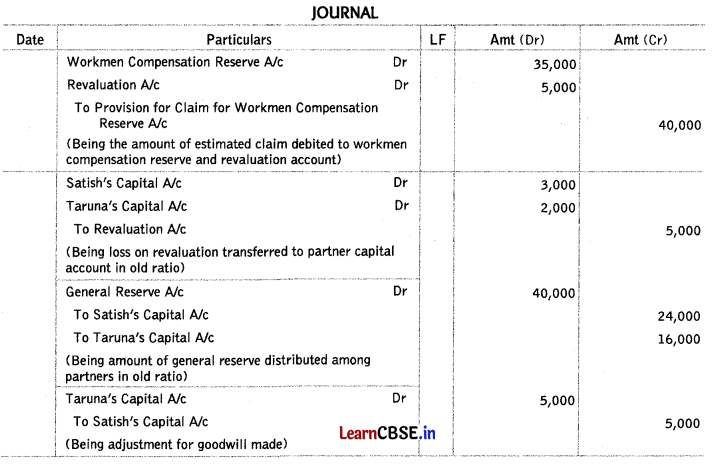
Question 9.
L, M and N were partners in a firm sharing profits in the ratio of 2 : 3 : 5. From 1st April, 2018 they decided to share the profits in the ratio of 1: 2 : 2. On this date, the Balance Sheet showed a credit balance of ₹ 1,17,000 in General Reserve and a debit balance of ₹ 35,000 in profit and loss account. The goodwill of the firm was valued at ₹ 5,00,000. The revaluation of assets and reassessment of liabilities resulted into a gain of ₹ 30,000.
Pass necessary journal entries for the above transactions on the reconstitution of the firm. (All India 2019)
Answer:
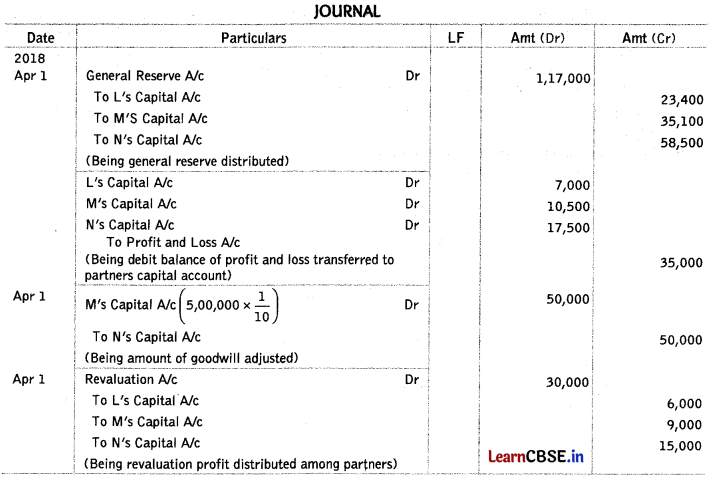
Working Note:
Calculation of Sacrificing and Gaining Ratio
Sacrificing Ratio = Old Share – New Share

Question 10.
P, Q and R were partners in a firm sharing profits in the ratio of 1 : 1 : 2. On 31st March, 2018, their balance sheet showed a credit balance of ₹ 9,000 in the profit and loss account and a Workmen Compensation Fund of ₹ 64,000. From 1st April, 2018 they decided to share profits in the ratio of 2 : 2 : 1. For this purpose it was agreed that:
(a) Goodwill of the firm was valued at ₹ 4,00,000.
(b) A claim on account of workmen compensation of ₹ 30,000 was admitted.
Pass necessary journal entries on reconstitution of the firm. (Delhi 2019)
Answer:
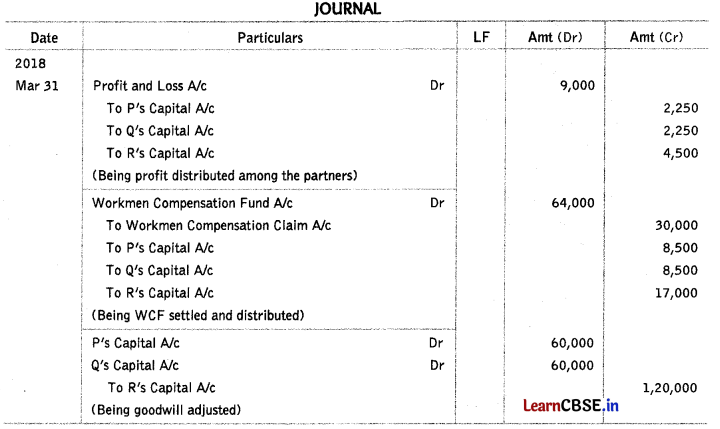
Working Note:
Calculation of Sacrificing or Gaining Ratio
Sacrificing ratio = Old share – New share
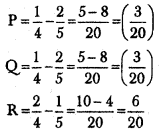
![]()
Question 11.
Aman, Bobby and Chandani were partners in a firm sharing profit and losses in the ratio of 5 : 4 : 1. From 1st April, 2018 they decided to share profit equally. The revaluation of assets and re-assessment of liabilities resulted in a loss ₹ 5,000. The goodwill of the firm on its reconstitution was valued at ₹ 1,20,000. The firm had a balance 20,000 in general reserve.
Showing your workings clearly pass necessary journal entries on the reconstitution of the firm. (Delhi 2019)
Answer:

Working note:
Calculation of Sacrificing or Gaining Ratio
Sacrificing Ratio = Old Share – New Share

Question 12.
Radhika, Bani and Chitra were partners in a firm sharing profits and losses in the ratio of 2 : 3 : 1. With effect from 1st April, 2018 they decided to share future profits and losses in the ratio of 3 : 2 : 1. On that date their Balance Sheet showed a debit balance of ₹ 24,000 in Profit and Loss Account and a balance of ₹ 1,44,000 in general reserve. It was also agreed that:
(a) The goodwill of the firm be valued at ₹ 1,80,000.
(b) The land (having book value of ₹ 3,00,000) will be valued at ₹ 4,80,000.
Pass the necessary journal entries for the above changes. (Delhi 2019)
Answer:
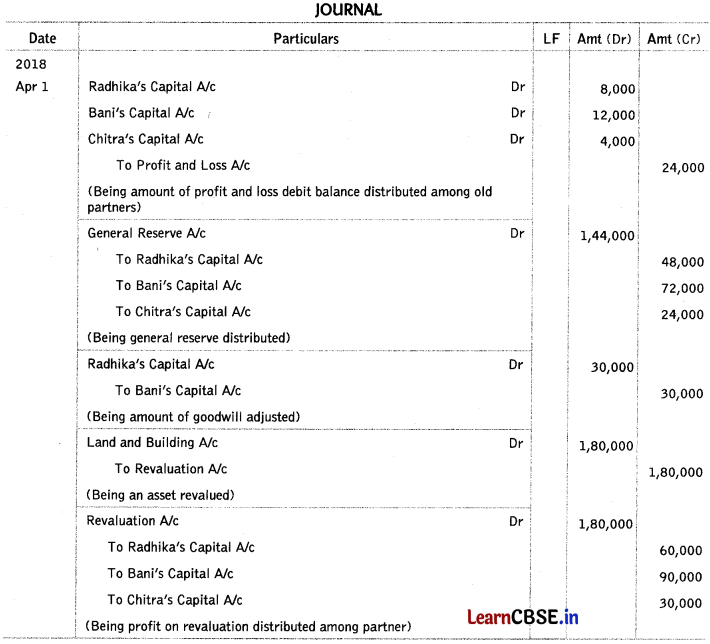
Working Notes:
1. Calculation of Sacrificing or Gaining Ratio
Sacrificing Ratio = Old Share – New Share
Radhika = \(\frac{2}{6}-\frac{3}{6}=\left(\frac{1}{6}\right)\) = Bani = \(\frac{3}{6}-\frac{2}{6}=\frac{1}{6}\) Chitra = \(\frac { 1 }{ 6 }\) – \(\frac { 1 }{ 6 }\) = Nil
2. Firms Goodwill = ₹ 1,80,000
Radhika gains and Bani sacrifice = 1,80,000 × \(\frac { 1 }{ 6 }\) = ₹ 30,000
Question 13.
Kumar, Gupta and Kavita were partners in a firm sharing profits and losses equally. The firm was engaged in the storage and distribution of canned juice and its godowns were located at three different places in the city. Each godown was being managed individually by Kumar, Gupta and Kavita. Because of increase in business activities at the godown managed by Gupta, he had to devote more time.
Gupta demanded that his share in the profits of the firm be increased, to which Kumar and Kavita agreed. The new profit sharing ratio was agreed to be 1 : 2 : 1.
For this purpose the goodwill of the firm was valued at two years’ purchase of the average profits of last five years. The profits of the last five years were as follows
| Year | Profit (₹) |
| I | 4,00,000 |
| II | 4,80,000 |
| III | 7,33,000 |
| IV (Loss) | 33,000 |
| V | 2,20,000 |
You are required to
(i) Calculate the goodwill of the firm.
(ii) Pass necessary journal entry for the treatment of goodwill on change in profit sharing ratio of Kumar, Gupta and Kavita. (Delhi 2015)
Answer:
(i) Calculation of Goodwill of the Firm
Average Profit = \(\frac{4,00,000+4,80,000+7,33,000-33,000+2,20,000}{5}=\frac{18,00,000}{5}\) = ₹ 3,60,000
Goodwill = Average Profits × Number of Years’ Purchase
= 3,60,000 × 2 = ₹ 7,20,000

Working Note:
Calculation of Sacrifice or Gain of Each Partner
Sacrificing/(Gaining) Share = Old Share – New Share
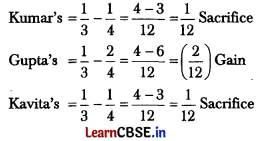
Calculation of Share of Goodwill:
Kumar = 7,20,000 × \(\frac { 1 }{ 12 }\) = ₹ 60,000, Gupta = 7,20,000 × \(\frac { 2 }{ 12 }\) = ₹ 1,20,000
Kavita = 7,20,000 × \(\frac { 1 }{ 12 }\) = ₹ 60,000
Question 14.
Anita, Asha and Amrit are partners sharing profits in the ratio of 3 : 2 : 1 respectively. From 1st January, 2010, they decided to share profits in the ratio of 1: 1 : 1. The partnership deed provided that in the event of any change in profit sharing ratio, the goodwill should be valued at three years’ purchase of the average of five years’ profits. The profits and losses of the preceding five years are
| Year | Profit (₹) |
| 2005 | 1,20,000 |
| 2006 | 3,00,000 |
| 2007 | 3,40,000 |
| 2008 | 3,80,000 |
| 2009 | 1,40,000 (Loss) |
Showing the working clearly, give the necessary journal entry to record the above change. (Delhi (C) 2010)
Answer:
Solve as Q no. 13 on page 84 and 85.
Debit Amrit’s Capital Account with ₹ 1,00,000 and Credit Anita’s Capital Account with ₹ 1,00,000.
Question 15.
P, Q and R were partners in a firm sharing profits and losses in the ratio of 3 : 2 : 1. On 31st March, 2018 their Balance Sheet was as follows:

On the above date the firm was reconstituted and it was decided that:
(i) The new profit sharing ratio will be 2 : 2 : 1.
(ii) Bad debts ₹ 6,000 were to be written-off and a provision of ₹ 3,000 was to be made for bad and doubtful debts.
(Hi) The capital of the partners will be adjusted in the new firms in their profit sharing ratio. For this, partners’ current accounts will be opened.
Pass the necessary journal entries on the reconstitution of the firm. (All India 2013)
Answer:
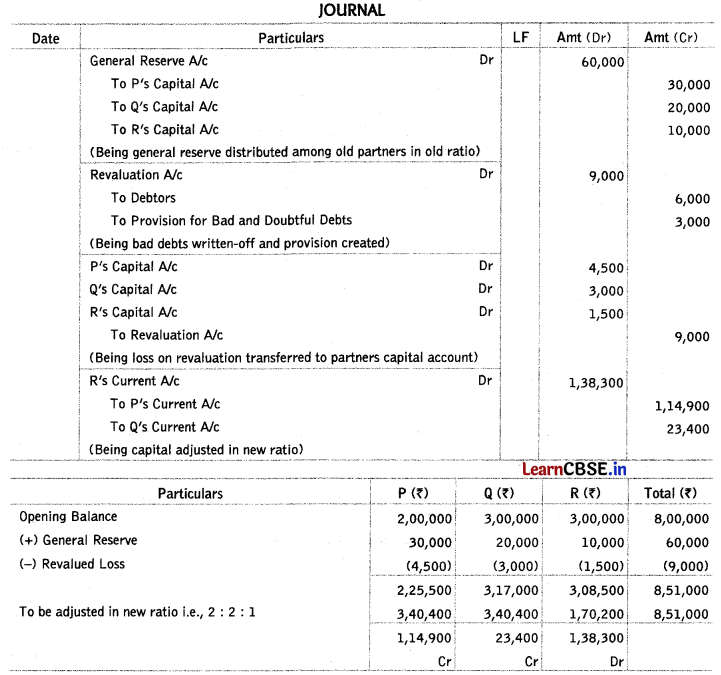
Question 16.
Parth, Raman and Zaisha are partners in a firm manufacturing furniture. They have been sharing profits and losses in the ratio of 5 : 3 : 2. From 1st April, 2017 they decided to share future profits and losses in the ratio of 2 : 5 : 3. Their Balance Sheet showed a debit balance of ₹ 74,000 in Profit and Loss Account; balance of ₹ 36,000 in General Reserve and a balance of ₹ 12,000 in Workmen’s Compensation Reserve. It was agreed that:
(i) The goodwill of the firm be valued at ₹ 76,000.
(ii) The stock (book value of ₹ 40,000) was to be depreciated by 8%.
(iii) Creditors amounting to ₹ 900 were not likely to be claimed.
(iv) Claim on account of Workmen’s Compensation amounted to ₹ 20,000.
(v) Investments (bool value ₹ 38,000) were revalued at ₹ 40,000.
Pass necessary journal entries for the above, comportment 2018 Modified
Answer:
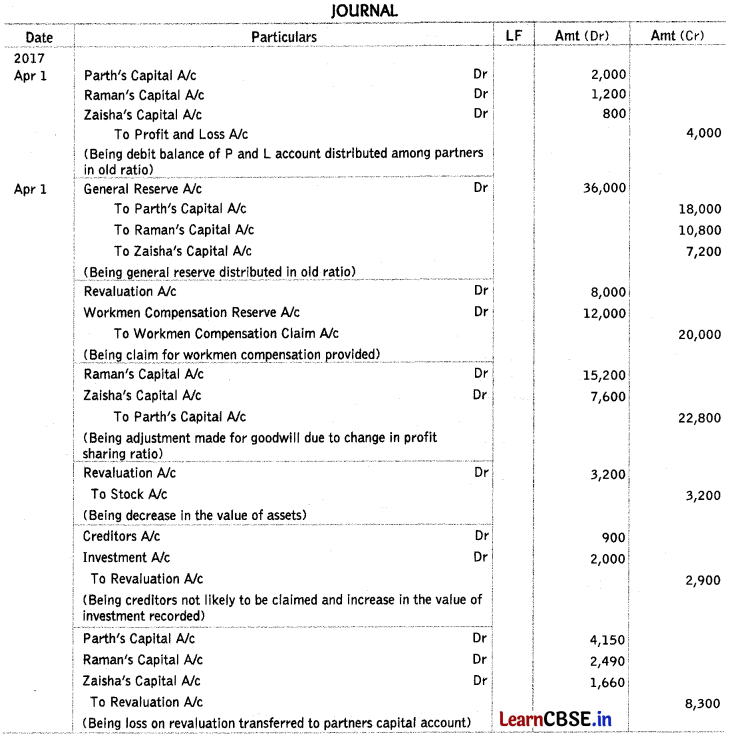
Working Note:
Calculation of Gaining/Sacrificing Ratio
Sacrificing Ratio = Old Ratio – New Ratio
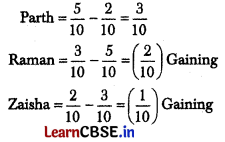
![]()
Question 17.
A, B, C and D were partners in a firm sharing profits in the ratio of 3 : 2 : 3 : 2. On 1st April, 2016 their balance sheet was as follows
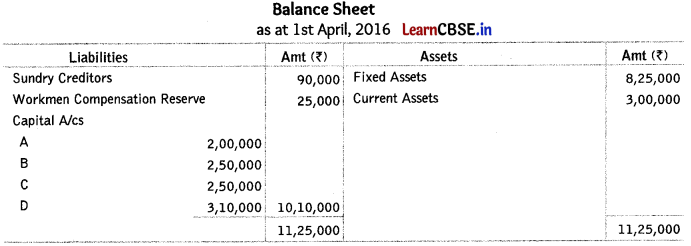
From the above date the partners decided to share the future profits in the ratio of 4 : 3 : 2 : 1. For this purpose the goodwill of the firm was valued at ₹ 2,70,000.
It was also considered that:
(i) Claim against workmen compensation reserve will be estimated at ₹ 30,000 and fixed assets will be depreciated by 25,000.
(it) The capitals of the partners will be adjusted according to the new profit sharing ratio by opening current accounts of the partners.
Prepare revaluation account, partners’ capital accounts and the balance sheet of the reconstituted firm. (All India 2017)
Answer:
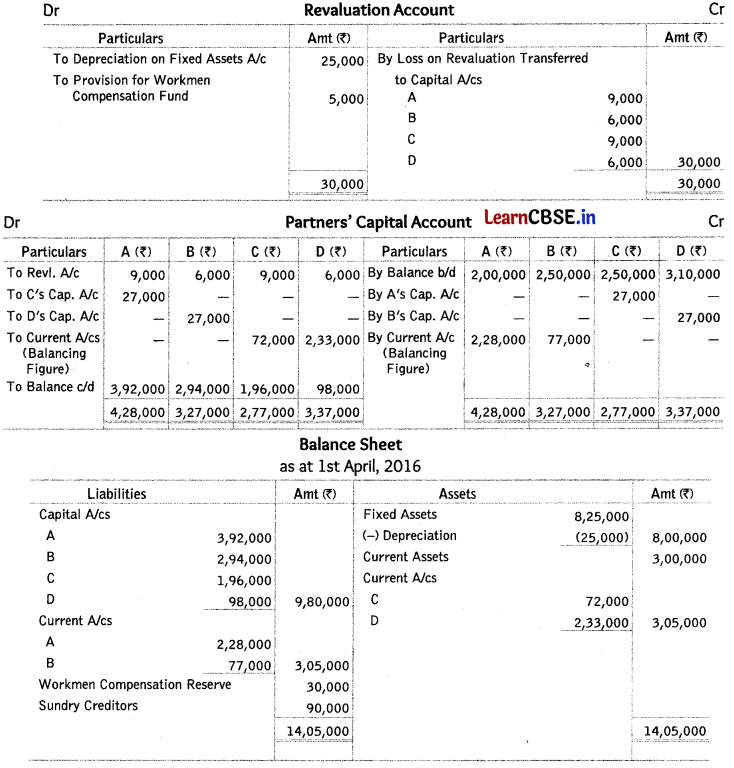
Working Notes:
1. Calculation of Sacrificing/ (Gaining) Share
Sacrificing/(Gaining) Share = Old Share – New Share

2. Calculation of Goodwill:
A’s share of goodwill = 2,70,000 × \(\frac { 1 }{ 10 }\) = ₹ 27,000
B’s share of goodwill = 2,70,000 × \(\frac { 1 }{ 10 }\) = ₹ 27,000
C’s share of goodwill = 2,70,000 × \(\frac { 1 }{ 10 }\) = ₹ 27,000
D’s share of goodwill =2,70,000 × \(\frac { 1 }{ 10 }\) = ₹ 27,000
3. Journal Entry Showing Adjustment for Goodwill

While posting in ledger, it has been assumed that A pays to C and B pays to D.
4. Calculation of Adjusted Capitals:
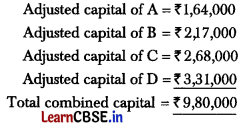
New capital of A = 9,80,000 × \(\frac { 4 }{ 10 }\) = ₹ 3,92,000
New capital of B = 9,80,000 × \(\frac { 3 }{ 10 }\) = ₹ 2,94,000
New capital of C = 9,80,000 × \(\frac { 2 }{ 10 }\) = ₹ 1,96,000
New capital of D = 9,80,000 × \(\frac { 1 }{ 10 }\) = ₹ 98,000
Question 18.
S, T, U and V were partners in a firm sharing profits in the ratio of 4 : 3 : 2 : 1. On 1st April, 2016 their balance sheet was as follows
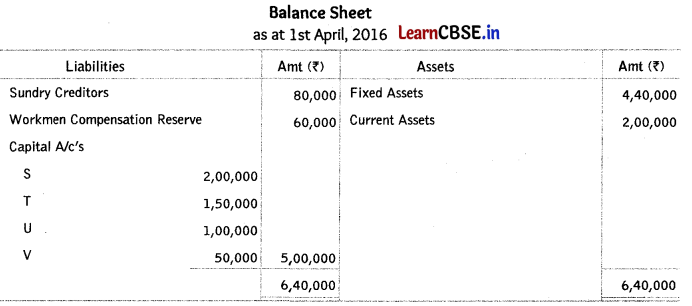
From the above date the partners decided to share the future profits in 3 : 1 : 2 : 4 ratio. For this purpose the goodwill of the firm was valued at ₹ 90,000.
The partners also agreed for the following
(i) The claim for workmen compensation has been estimated at ₹ 70,000.
(ii) To adjust the capitals of the partners according to new profit sharing ratio by opening partners’ current accounts.
Prepare revaluation account, partners’ capital accounts and the balance sheet of the reconstituted firm. (Delhi 2017)
Answer:
Solve as Q no. 17 on page 88-90.
Loss on Revaluation : S = ₹ 4,000, T = ₹ 3,000, U = ₹ 2,000, V = ₹ 1,000
Balance in Partners’ Capital Account: S = ₹ 1,47,000, T = ₹ 49,000, U = ₹ 98,000, V = ₹ 1,96,000.
Balance in Partners’ Current Account: S = ₹ 58,000 (Cr), T = ₹ 1,16,000 (Cr), V = ₹ 1,74,000 (Dr)
Total of Balance Sheet = ₹ 8,14,000
Question 19.
R, S and T were partners in a firm sharing profits in 1 : 2 : 3 ratio. Their balance sheet as at 31st March, 2015 was as follows
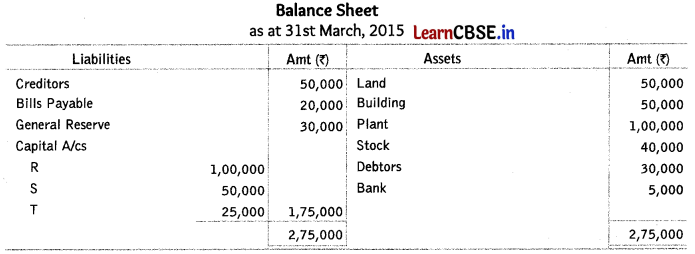
From 1st April, 2015 R, S and T decided to share the future profits equally. For this purpose it was decided that
(i) Goodwill of the firm be valued at ₹ 1,50,000.
(ii) Land be revalued at ₹ 80,000 and building be depreciated by 6%.
(iii) Creditors of ₹ 6,000 were not likely to be claimed and hence be written-off.
Prepare revaluation account, partners’ capital accounts and the balance sheet of the reconstituted firm. (All India 2016)
Answer:
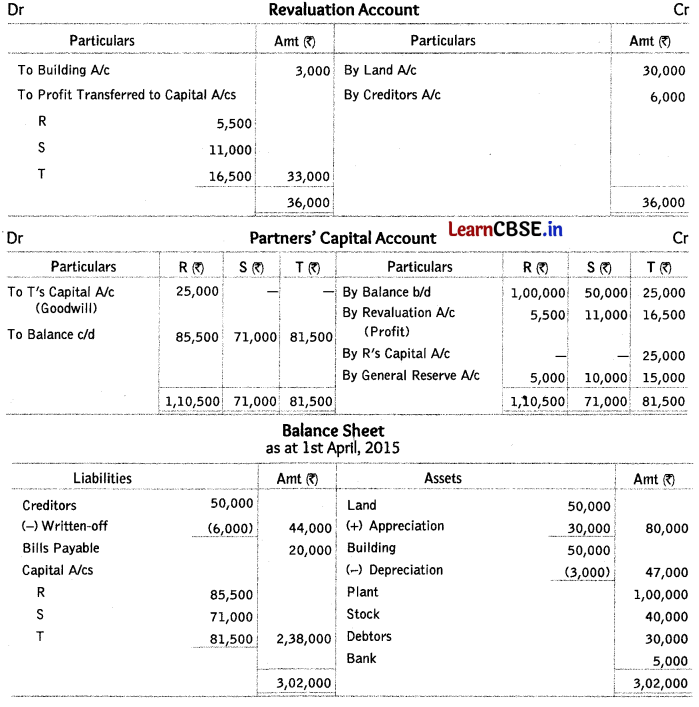
Working Note:
Calculation of Sacrifice or Gain of Each Partner
Sacrificing/(Gaining) Share = Old Share – New Share
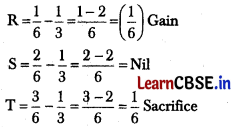
Firm’s goodwill = ₹ 1,50,000
R will pay for goodwill = 1,50,000 × \(\frac { 1 }{ 6 }\) = ₹ 25,000
R’s Capital A/c Dr – 25,000
To T’s Capital A/c – 25,000
Question 20.
Ashok, Bhim and Chetan were partners in a firm sharing profits in the ratio of 3 : 2 : 1. Their balance sheet as at 31st March, 2015 was as follows
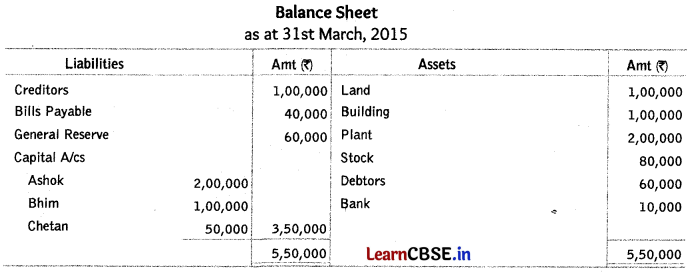
Ashok, Bhim and Chetan decided to share the future profits equally, with effect from 1st April, 2015. For this it was agreed that:
(i) Goodwill of the firm be valued at ₹ 3,00,000.
(ii) Land be revalued at ₹ 1,60,000 and building be depreciated by 6%.
(iii) Creditors of ₹ 12,000 were not likely to be claimed and hence be written off. Prepare revaluation account, partners’ capital accounts and balance sheet of the reconstituted firm. (Delhi 2016)
Answer:
Solve as Q. no. 19 on page 91-92.
Profit on Revaluation: Ashok = ₹ 33,000, Bhim = ₹ 22,000, Chetan = ₹ 11,000
Balance in Partners’ Capital Account: Ashok = ₹ 313,000, Bhim = ₹ 142000, Chetan = ₹ 21000
Total of Balance Sheet = ₹ 604000.
Question 21.
Change in relationship among partners is called
(a) dissolution of firm
(b) reconstitution of firm
(c) insolvency of firm
(d) None of these
Answer:
(b) reconstitution of firm
![]()
Question 22.
Which of the following is used to find out sacrificing ratio?
(a) Old Share – New Share
(b) New Share – Old Share
(c) Old Share – Gain Share
(d) None of the above
Answer:
(a) Old Share – New Share
Question 23.
X, Y and Z are partners sharing profits and losses in the ratio of 5 : 4 : 1. Calculate sacrificing or gaining share for each if Z acquires \(\frac { 1 }{ 10 }\)th share of X and \(\frac { 1 }{ 2 }\) share of Y.
(a) X Sacrifice = \(\frac { 5 }{ 100 }\), Y = \(\frac { 20 }{ 100 }\), Z Sacrifice = \(\frac { 25 }{ 100 }\)
(b) X Sacrifice = \(\frac { 5 }{ 100 }\), Y Sacrifice = \(\frac { 20 }{ 100 }\), Z gains = \(\frac { 25 }{ 100 }\)
(c) X Gains = \(\frac { 5 }{ 100 }\), Y Gains = \(\frac { 20 }{ 100 }\), Z Sacrifice = \(\frac { 25 }{ 100 }\)
(d) None of the above
Answer:
(b) X Sacrifice = \(\frac { 5 }{ 100 }\), Y Sacrifice = \(\frac { 20 }{ 100 }\), Z gains = \(\frac { 25 }{ 100 }\)
Question 24.
‘P’, ‘Q’ and ‘R’ are partners sharing profits and losses in the ratio of 5 : 3 : 2. Their new profit sharing ratio will be equal. Which partner has sacrificed and by how much?
(a) Q = \(\frac { 4 }{ 30 }\)
(b) R = \(\frac { 1 }{ 30 }\)
(c) P = \(\frac { 5 }{ 30 }\)
(d) Q = \(\frac { 1 }{ 100 }\) and R = \(\frac { 4 }{ 40 }\)
Answer:
(c) P = \(\frac { 5 }{ 30 }\)
Question 25.
Reserves are distributed in old partners in …………. ratio.
(a) old
(b) gain
(c) new
(d) sacrifice
Answer:
(a) old
Question 26.
The entry to be passed for adjustment of goodwill when there is a change in profit (loss) sharing ratio of partners, without opening goodwill account is
(a) Sacrificing Partners’ Capital A/c Dr
To Gaining Partners’ Capital A/c
(b) Gaining Partners’ Capital A/c Dr
To Sacrificing Partners’ Capital A/c
(c) Gaining Partners’ Current A/c Dr
To Sacrificing Partners’ Current A/c
(d) Either (b) or (c)
Answer:
(d) Either (b) or (c)
Question 27.
When a firm is reconstituted, reserves and accumulated profits are distributed among partners by passing the following journal entry.
(a) Reserves/Profit and Loss A/c Dr
Workmen’s Compensation Reserve A/c Dr
Investment Fluctuation Reserve A/c Dr
To All Partner’s Capital A/c
(b) Reserves/Profit and Loss A/c Dr
Workmen’s Compensation Reserve A/c Dr
Investment Fluctuation Reserve A/c Dr
To All Partner’s Current A/c
(c) Either (a) or (b)
(d) None of the above
Answer:
(c) Either (a) or (b)
Question 28.
If their is a change in profit sharing ratio of existing partners and the question is silent about investment fluctuation reserve, then it is distributed among partners in
(a) old ratio
(b) new ratio
(c) sacrificing ratio
(d) gaining ratio
Answer:
(a) old ratio
Question 29.
Revaluation account is account in nature.
(a) real
(b) personal
(c) nominal
(d) None of the above
Answer:
(c) nominal
![]()
Question 30.
Whenever revaluation account is prepared, the journal entry for unrecorded assets is
(a) Unrecorded Assets A/c Dr
To Revaluation A/c
(b) Revaluation A/c Dr
To Unrecorded Assets A/c
(c) Revaluation A/c Dr
To Partner’s Capital A/c
(d) None of the above
Answer:
(a) Unrecorded Assets A/c Dr
To Revaluation A/c